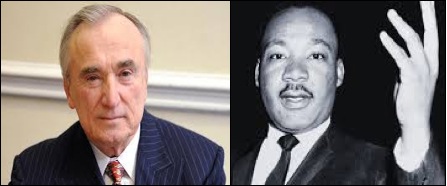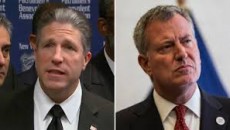Can The Community & Police Fulfill The Dream of King? (Part 3 of 5)
By Understanding the Dream of Dr. King and How Poverty Affects Community and Police Relationships We Can Focus on Real Solutions to the Problems That Keep Us Apart
 As we continue to explore the role poverty may play in police/community relations so we can assess and recommend some solutions to the problem, on March 31, 1968, just 4 days before his assignation, Dr. King presented one of his last speeches at the National Cathedral in Washington, D.C. He titled the sermon, “Remaining Awake Through a Great Revolution.” During the sermon he stated, “This is America’s opportunity to help bridge the gulf between the haves and the have-nots. The question is whether America will do it.” The sermon would serve as a preview for what Dr. King and other civil rights leaders called the “Poor People’s Campaign,” and served as an opportunity to push for economic justice from Congress and President Johnson. The middle class and the poor citizens of today need to push a little harder for the same economic justice as well.
As we continue to explore the role poverty may play in police/community relations so we can assess and recommend some solutions to the problem, on March 31, 1968, just 4 days before his assignation, Dr. King presented one of his last speeches at the National Cathedral in Washington, D.C. He titled the sermon, “Remaining Awake Through a Great Revolution.” During the sermon he stated, “This is America’s opportunity to help bridge the gulf between the haves and the have-nots. The question is whether America will do it.” The sermon would serve as a preview for what Dr. King and other civil rights leaders called the “Poor People’s Campaign,” and served as an opportunity to push for economic justice from Congress and President Johnson. The middle class and the poor citizens of today need to push a little harder for the same economic justice as well.
Poverty and crime are partners as described by experts from all fields, from sociologists to economists. The UN and the World Bank both rank crime high on the list of obstacles, which hinder the growth of developing countries. Crime hinders the growth of any community by generating instability. That’s why it is hard to build a successful business in crime-infested and disenfranchised neighborhoods. In addition, poverty and crime also breed corruption within our government and law enforcement agencies. This further compromises public trust in law enforcement agencies.
 Despite 5 years of economic recovery, poverty, like the rent, is still way too high in America. The annual income threshold for being counted as living in poverty was $11,490 last year for a person and $23,550 for a family of 4. The black poverty rate was 27.2%, unchanged from 2012 and higher than 24.3% before the recession began. More than 11 million black Americans lived below the poverty level last year. About 42.5% of the households headed by single black women were in poverty. The Hispanic poverty rate was 23.5%. In 2013 the following were living in poverty: 45.3 million citizens (14.5%); 26.4 million citizens (13.6%) ages 18-64; 14.7 million children (19.9%) under the age of 18; and 14.2 million (9.5%) seniors 65 and older.
Despite 5 years of economic recovery, poverty, like the rent, is still way too high in America. The annual income threshold for being counted as living in poverty was $11,490 last year for a person and $23,550 for a family of 4. The black poverty rate was 27.2%, unchanged from 2012 and higher than 24.3% before the recession began. More than 11 million black Americans lived below the poverty level last year. About 42.5% of the households headed by single black women were in poverty. The Hispanic poverty rate was 23.5%. In 2013 the following were living in poverty: 45.3 million citizens (14.5%); 26.4 million citizens (13.6%) ages 18-64; 14.7 million children (19.9%) under the age of 18; and 14.2 million (9.5%) seniors 65 and older.
 To defeat Poverty we need: better schools in poor communities; quality jobs and training programs for youth, the unemployed, unemployable and the underemployed; programs that prepare citizens for the world of work and entrepreneurial opportunities; investments of time and money by the rich, celebrities, banks and corporate America in poor and disadvantaged communities; and teach minorities the importance of voter registration, education, and participation so that they can take control of their own communities. Education does matter as it relates to poverty. Those with a high school diploma or less had higher poverty rates than those with some college. About 10% of those with less than a high school diploma live just above the poverty level, compared with 1.6% of college graduates. But in a tough economic climate, and as more people go to college, even degrees may not help. 12% of people living near poverty have at least a college degree. Through the “Power of Politics” you can put the person you trust in office and know for sure that your interests will be represented. This is how you start to put an end to poverty and inequality, as well as bad relations between the community and law enforcement agencies.
To defeat Poverty we need: better schools in poor communities; quality jobs and training programs for youth, the unemployed, unemployable and the underemployed; programs that prepare citizens for the world of work and entrepreneurial opportunities; investments of time and money by the rich, celebrities, banks and corporate America in poor and disadvantaged communities; and teach minorities the importance of voter registration, education, and participation so that they can take control of their own communities. Education does matter as it relates to poverty. Those with a high school diploma or less had higher poverty rates than those with some college. About 10% of those with less than a high school diploma live just above the poverty level, compared with 1.6% of college graduates. But in a tough economic climate, and as more people go to college, even degrees may not help. 12% of people living near poverty have at least a college degree. Through the “Power of Politics” you can put the person you trust in office and know for sure that your interests will be represented. This is how you start to put an end to poverty and inequality, as well as bad relations between the community and law enforcement agencies.
 As protests continue throughout the country it is the built-up frustrations of the poor over unjust policies, the economy, and the way they are treated by law enforcement officers that give them a reason in their mind to lash out. It appears that the “divide and conquer” plot by the rich is still winning. Dr. King dared us to “be dissatisfied until the tragic walls that separate the outer city of wealth and comfort from the inner-city of poverty and despair shall be crushed by the battering rams of the forces of justice.” As we celebrate his life and legacy, we should reflect on his commitment to fight all forms of inequality and reaffirm our commitment to follow his example. If there was ever a time for the Community Affairs Division of the Police to reach out and go the extra mile to make friends with the citizens, this is your “Call to Action”. The health, welfare and safety of all citizens and the officers who have to hit the streets to protect and serve are all at stake. Good citizens want to help put out the fire before it burns out of control, but law enforcement agencies must meet them half way.
As protests continue throughout the country it is the built-up frustrations of the poor over unjust policies, the economy, and the way they are treated by law enforcement officers that give them a reason in their mind to lash out. It appears that the “divide and conquer” plot by the rich is still winning. Dr. King dared us to “be dissatisfied until the tragic walls that separate the outer city of wealth and comfort from the inner-city of poverty and despair shall be crushed by the battering rams of the forces of justice.” As we celebrate his life and legacy, we should reflect on his commitment to fight all forms of inequality and reaffirm our commitment to follow his example. If there was ever a time for the Community Affairs Division of the Police to reach out and go the extra mile to make friends with the citizens, this is your “Call to Action”. The health, welfare and safety of all citizens and the officers who have to hit the streets to protect and serve are all at stake. Good citizens want to help put out the fire before it burns out of control, but law enforcement agencies must meet them half way.
Once again some officers turned their backs as Mayor de Blasio spoke at the second funeral of an NYC police officer. This public feud has been going on now for weeks with no relief in sight. It started at the hospital when the Mayor went to visit the officers and continued at just about every event the Mayor spoke at where officers were present. Now we know that the PBA does not have a contract and again the “Poverty/Money Bell” has sounded. We don’t believe that money is the main cause of the hostility, but to on-lookers it may be playing a contributing role. No matter what the reason, it does not look good especially during these dangerous times of unrest and mistrust. We resect the Union and the Mayor and want them to know that young people are watching, but so are the criminals. As long as they are publicly divided it sends the wrong message because to win the “War on Crime” we need every citizen to feel that our leaders have not allowed themselves to be “Divided & Conquered.” A divided leadership is a sign of chaos and that is not the image we want to portray to our youth.
After meeting with several student groups over the last 4 weeks it was our hope that the beef would be settled by the end of the holiday, but apparently it continues. So in partnership because of concern and support for our students, youth and young adults, we will be reaching out this week to Mayor Bill de Blasio and PBA President Pat Lynch asking if they would meet together with a host of “Student Groups” to ensure them that their differences will not compromise public safety, and that they would work harder to put an end to the public feud, which hinders the movement to improve relations between the Police and law enforcement agencies.
To get respect you have to give it in return and you can’t ask students and young community residents to show respect, love and support for the Police if representatives are not showing the same within their own ranks. As far as the people are concerned the Mayor, the Unions and Government agencies are all of the same cloth. You can’t separate the fingers from the hand. We will keep our readers abreast of the progress as the community attempts to mediate the problem so that we can take back our communities and rebuild relations between good citizens and law enforcement agencies. The next segment (Part 4) of the series will focus on “Black-on-Black Crime” and how it has also contributed to the problem of poor relations between the Police and the Community. For further info on the “Rap 2 Bridge the Gap” initiative or to make comments and/or find information related to the 5 part series hit us up at: RandyKFisher@gmail.com.
Posted by Charles and Randy Fisher (Twitter / Facebook / Instagram @HHSYC).
Part 2 of 5: http://thesource.com/2015/01/05/poverty-the-police-and-the-community-part-2-of-5
Part 1 of 5: http://thesource.com/2015/01/02/can-the-dream-of-king-improve-police-community-relations-part-1-of-5


